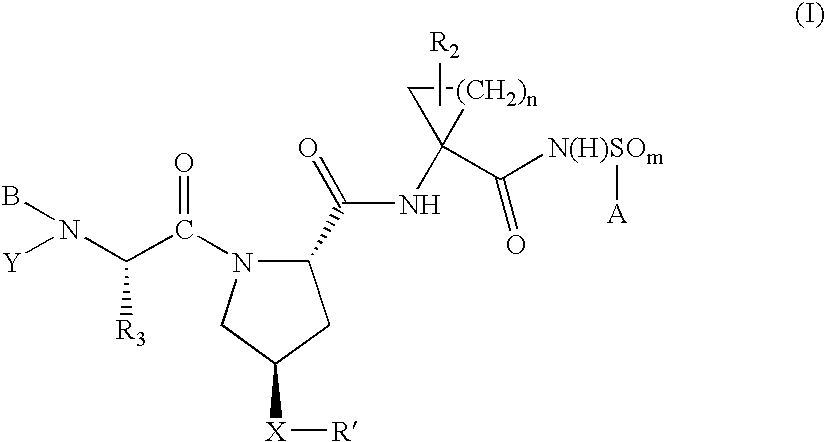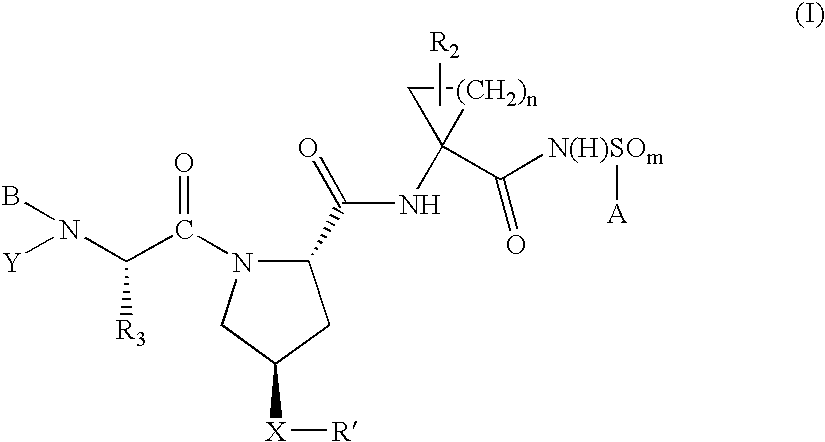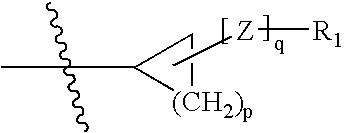Hepatitis C virus inhibitors
- Summary
- Abstract
- Description
- Claims
- Application Information
AI Technical Summary
Benefits of technology
Problems solved by technology
Method used
Image
Examples
example 100
Preparation of Compound 100
[0366]
Step 1
[0367] To a solution of 2-methoxy cinnamic acid (10.0 g) in CH2Cl2 (100 ml) was added thionyl chloride (40 ml). After refluxing for 4 h, the reaction mixture was concentrated in vacuo. The crude product was used for next step without purification.
Step 2
[0368] To a solution of 3-(2-methoxy-phenyl)-acryloyl chloride (Product of Step 1, 11.0 g, 56 mmol)) in acetone (100 ml) was added sodium azide (9.1 g, 240 mmol) in water (30 ml). The mixture was stirred at room temperature for 3 h and the solvent was evaporated in vacuo. The residue was extracted with diphenylmethane (50 ml) and the organic layer was washed with water and dried over MgSO4. This solution was used for next step without purification.
Step 3
[0369] Diphenylmethane (50 ml) was heated to 200° C., and the solution of 3-(2-methoxy-phenyl)-acryloyl azide in diphenylmethane (Product of Step 2) was added dropwise. After completion of addition, the mixture was refluxed for 4 h and then c...
example 101
Preparation of Compound 101
[0374]
[0375] Compound 101 was prepared by following Steps 1 through 5 described in Example 100 except that the following modifications were made:
Step 1-3
[0376] 2-Chlorocinnamic acid (25.0 g) was used as starting material and 14.6 g (59%) of product was obtained.
[0377]1H NMR (400 MHz, CD3OD) δ ppm 7.22 (d, J=7.3 Hz, 1H), 7.42 (t, J=7.8 Hz, 1H), 7.73 (d, J=7.8 Hz, 1H), 8.34 (d, J=8.1 Hz, 1H), 10.61 (s, 1H); MS 180 (M+H)+.
Step 4
[0378] 5-Chloro-2H-isoquinolin-1-one (Product of Step 3, 14.6 g) was used as starting material and 8.28 g (53%) of product was obtained.
[0379]1H NMR (400 MHz, CDCl3) δ ppm 7.60 (dd, J=8. 6, 7.6 Hz, 1H), 7.83 (m, 1H), 8.00 (d, J=5.9 Hz, 1H), 8.29 (dt, J=8.9, 1.0 Hz, 1H), 8.38 (d, J=5.9 Hz, 1H); MS 198 (M+H)+.
Step 5
[0380] 1,5-Dichloro-isoquinoline (Product of Step 4, 20 mg) was used as starting material and 24 mg (32%) of compound 101 was obtained. 1H NMR (400 MHz, CD3OD) δ ppm 0.96 (m, 5H), 1.03 (s, 9H), 1.21 (s, 9H), 1.42 (m,...
example 102
Preparation of Compound 102
[0381]
Step 1
[0382] A solution of β-chlorocinnamic acid (11.0 g, 60 mmol), diphenylphosphoryl azide (15.7 g, 57 mmol)), and triethylamine (10 ml) in benzene (80 ml) was stirred for 1 h. The reaction mixture was concentrated in vacuo at <50° C. and purified by flash column chromatograph (Biotage Flash 40M) eluted with 10% EtOAc in hexane to give the desired product (4.1 g, 34%).
Step 2
[0383] A solution of 3-chloro-3-phenyl-acryloyl azide (Product of Step 1, 4.1 g, 19.7 mmol) in diphenylmethane (40 ml) was heated up slowly and refluxed for 4 h. After cooling to room temperature, the precipitate was collected by filtration, washed with hexane and dried. The filtrates were concentrated in vacuo and purified by flash column chromatograph (Biotage Flash 40M) eluted with EtOAc:hexane (1:1) to give the second batch of product (total 3.1 g, 89%). 1H NMR (400 MHz, CD3OD) 8 ppm 7.34 (s, 1H), 7.52 (t, J=7.58 Hz, 1H), 7.77 (t, b-7.46 Hz, 1H), 7.90 (d, J=8.07 Hz, 1H), ...
PUM
| Property | Measurement | Unit |
|---|---|---|
| Current | aaaaa | aaaaa |
| Digital information | aaaaa | aaaaa |
| Pharmaceutically acceptable | aaaaa | aaaaa |
Abstract
Description
Claims
Application Information
 Login to View More
Login to View More - R&D
- Intellectual Property
- Life Sciences
- Materials
- Tech Scout
- Unparalleled Data Quality
- Higher Quality Content
- 60% Fewer Hallucinations
Browse by: Latest US Patents, China's latest patents, Technical Efficacy Thesaurus, Application Domain, Technology Topic, Popular Technical Reports.
© 2025 PatSnap. All rights reserved.Legal|Privacy policy|Modern Slavery Act Transparency Statement|Sitemap|About US| Contact US: help@patsnap.com



